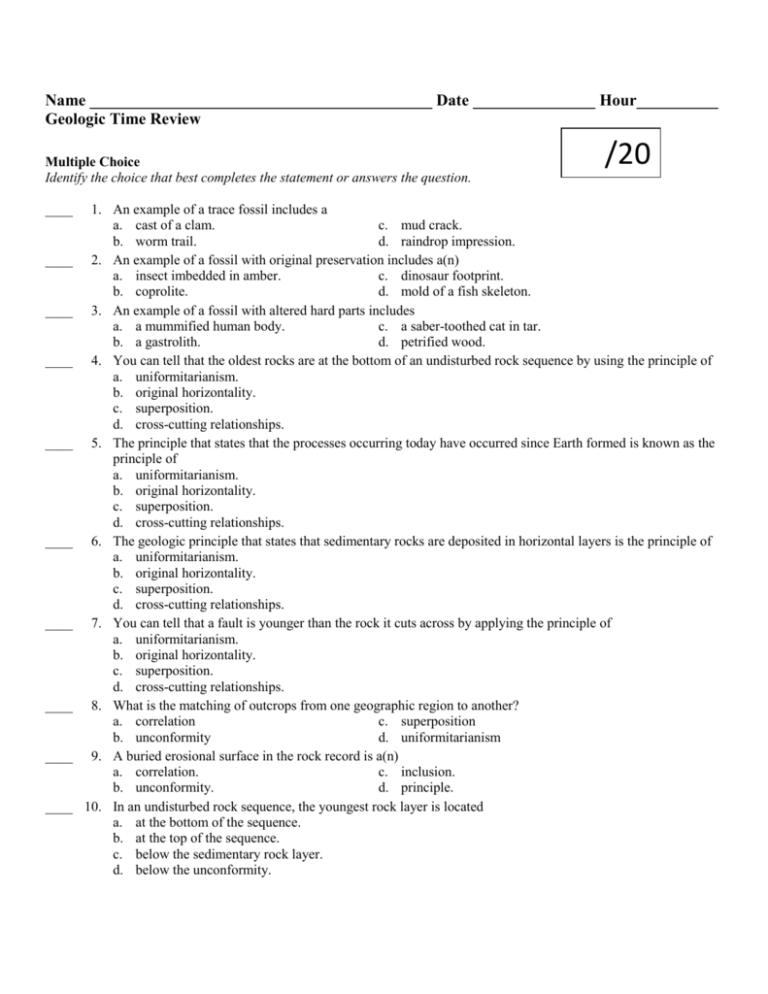Geologic Time Review
advertisement

Name __________________________________________ Date _______________ Hour__________ Geologic Time Review Multiple Choice Identify the choice that best completes the statement or answers the question. ____ ____ ____ ____ ____ ____ ____ ____ ____ ____ /20 1. An example of a trace fossil includes a a. cast of a clam. c. mud crack. b. worm trail. d. raindrop impression. 2. An example of a fossil with original preservation includes a(n) a. insect imbedded in amber. c. dinosaur footprint. b. coprolite. d. mold of a fish skeleton. 3. An example of a fossil with altered hard parts includes a. a mummified human body. c. a saber-toothed cat in tar. b. a gastrolith. d. petrified wood. 4. You can tell that the oldest rocks are at the bottom of an undisturbed rock sequence by using the principle of a. uniformitarianism. b. original horizontality. c. superposition. d. cross-cutting relationships. 5. The principle that states that the processes occurring today have occurred since Earth formed is known as the principle of a. uniformitarianism. b. original horizontality. c. superposition. d. cross-cutting relationships. 6. The geologic principle that states that sedimentary rocks are deposited in horizontal layers is the principle of a. uniformitarianism. b. original horizontality. c. superposition. d. cross-cutting relationships. 7. You can tell that a fault is younger than the rock it cuts across by applying the principle of a. uniformitarianism. b. original horizontality. c. superposition. d. cross-cutting relationships. 8. What is the matching of outcrops from one geographic region to another? a. correlation c. superposition b. unconformity d. uniformitarianism 9. A buried erosional surface in the rock record is a(n) a. correlation. c. inclusion. b. unconformity. d. principle. 10. In an undisturbed rock sequence, the youngest rock layer is located a. at the bottom of the sequence. b. at the top of the sequence. c. below the sedimentary rock layer. d. below the unconformity. ____ 11. What are particles eroded from a layer of rock that become incorporated in an overlying rock layer? a. fossils c. sills b. unconformities d. inclusions ____ 12. The rock layers beneath an eroded surface are at an angle to that surface in a(n) a. nonconformity. c. angular unconformity. b. disconformity. d. cross-cutting relationship. ____ 13. The relative age of a rock layer that contains inclusions is a. older than the source of the inclusions. b. older than the layer below it. c. younger than the source of the inclusions. d. the same as the intrusion that cuts across it. Completion Complete each statement. Use the list below to identify the term that best completes the statement. nonconformity correlation angular unconformity permineralization superposition cast cross-cutting relationships amber mold 14. The principle of ____________________ states that, in an undisturbed sequence, the oldest rocks are at the bottom of the sequence and successive layers are younger than those below them. 15. In the process of ____________________, pore spaces within an organism’s shell are filled in with mineral substances. 16. Fossil insects can be found imbedded in ____________________, the hardened sap of prehistoric trees. 17. A(n) ____________________ forms when the hollowed-out impression of a fossil organism becomes filled with minerals or sediment. 18. When the original parts of an organism in a sedimentary rock are weathered and eroded, a hollowed-out impression called a(n) ____________________ forms. 19. The gap in the rock record that occurs between folded or uplifted rock layers and a sedimentary rock layer on top of them is called a(n) _________________________. 20. You can use the principle of ___________________________________ to infer that a fault or an intrusion is younger than the rock it cuts across. 21. A buried erosional surface between a nonsedimentary rock and a sedimentary rock is called a(n) ____________________. 22. The matching of rock layers from one geographic area with those of another area is known as ____________________. Short Answer 23. Contrast relative age-dating and absolute-age dating. 24. List the characteristics of an index fossil. Problems 25. Use the diagram above to number the events below in the order in which they occurred. _____ H is deposited. _____ P intrudes and crystallizes. _____ L, M, N, O, P, and Q are uplifted and eroded. _____ M intrudes and crystallizes. _____ N is deposited _____ I is deposited. _____ J is deposited _____ Q is deposited. _____ J is eroded. _____ O is deposited. _____ K is deposited. _____ L is deposited. 26. Identify the two types of unconformities in the diagram and describe how they formed. 27. How old is a rock that has 851,078 atoms of N-14 and 13,506 atoms of C-14?







